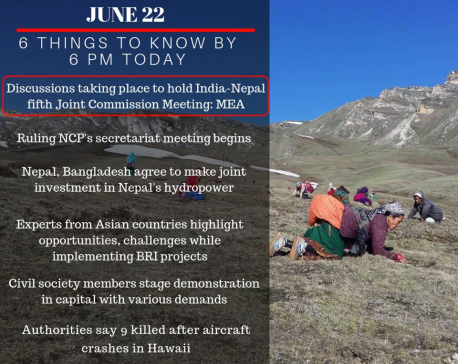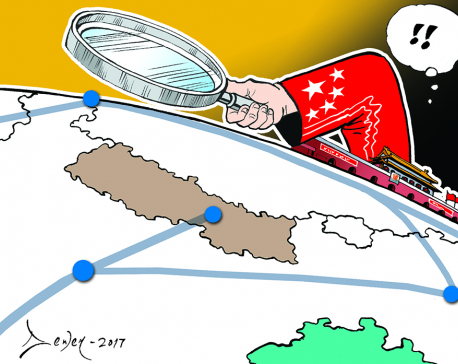
OR

More from Author
If Nepal is to join a club of emerging and advanced economies, its priorities should be to address how the transition should occur and what mechanisms should be applied to achieve it
For many decades, South East Asian countries went under-noticed. No more so. The politically and socio-economically turbulent region of the past attracted 11.5 percent of global FDI inflows worth around USD155 billion in 2018. The major reason for this economic impetus resides in their commitment for regionalism, enhanced connectivity to foster intra and inter-regional trade and innovation policies that stimulate socio-economic development. For Nepal, this achievement can provide valuable lessons in terms of policy measures and robust implementation mechanism to overcome ‘rent-seeking mentality’. Lessons from ASEAN economies are quintessential on grounds of our similar political, economic and cultural experiences and geo-proximity.
Greater integration
In Has the West Lost It? Kishore Mahbubani stresses on multilateralism, minimal engagement (on internal affairs) and Machiavellianism as 3 Ms for shared prosperity. In market economy, a zero sum game entails an emergence of one market means another’s slowdown. But ASEAN countries have provided an anti-thesis to this conviction identifying complimentary sectors to tap into their comparative advantages. For instance, an enhanced regional connectivity has led to higher growth, better productivity and increased access to market and such phenomenon also has provided an opportunity to contribute toward global value chain. Putting regional integration at the center, all economic players reaped most of what would not have been possible individually.
However, making regional association workable for Nepal appears to be major external challenge. Near defunct South Asian Association for Regional Cooperation (SAARC) will face heavy resistance if attempts are made to foster cross-border trade and connectivity. Amidst unresolved geo-political conflict, Nepal has no viable alternative other than bringing conflicting actors to negotiation table and build up a consensus. At the same time, modus operandi should be to push its economic ambition forward through other forums such as Bangladesh-Bhutan-India-Nepal (BBIN) and BIMSTEC. Connectivity such as cross-border transmission line and construction of regional highways can be a starting point. Nepal’s proactive diplomacy has a major role to strengthen regional connectivity as its economic ambitions depend on how well regionalism works to integrate South Asia.
Easing environment
Positive economic departure depends on effective policy measures, bureaucratic commitment and efficient investment facilitation services particularly digital one-stop service. Policy framework which has embedded efficacious incentives for innovators and entrepreneurs stimulate innovation-focused and innovation-driven behavior of national and global economic agents. What made ASEAN unique among other regional blocks is its creation, evaluation and piloting of array of policy alternatives to maximize social welfare and meet priority goals.
Despite many limitations, World Bank’s Ease of Doing Business Index (DBI) is one of the several studies that analyzes business environment globally. Among 190 economies, Thailand ranked 21st in 2020 becoming one of the leading reformers in the sector. Thailand also boosted making taxpaying process impressively easier by applying enhanced online platform for calculating and filing corporate income tax. Malaysia, another vibrant economy in ASEAN, pushed six reforms ranging from easing business startup to simplifying property transfer introducing online single window platform. Indonesia, the Philippines and Vietnam are some other economies in 10-nation bloc which overhauled their public revenue system pushing multiple reforms.
Foreign Direct Investment (FDI) always dominates political and economic agenda in number of countries. Nepal is embarking on economic transition after long and painful political turmoil in the last decade. It is still novice in attracting FDI unlike other peer countries and has a long way to go to become investor-darling nation by easing lots of business regulations. Nepal has no luxury to squander time with ‘trial-and-error’ decision making practices before discovering the best one. Our policy decisions should have a logical and mathematical calculation, and informed decision making should address proclivity and tendencies of investors. In simple terms, a policy decision should consider whether, why, what regulations investors want and how such regulations can govern and guide business activities. While Nepal secured 94th position on DBI, our improvement on real terms are not satisfactory. Among three indicators, access to credit and reduction in cost of construction improved our performance but new regulations more likely seem to block startups and innovations rather than paving way for their smooth operation and growth. More pragmatic approach to attract FDI would be to improve on such outlook through better understanding of how macro-level policy decision drives behavior of micro-level investors, entrepreneur and innovators, and vice-versa.
Creating incentives
ASEAN’s latest report shows that the prime reason for continued dynamism relies on surge in FDI in manufacturing sector by 83 percent in 2018 compared to USD $30 billion earlier year. In any country, an enhanced manufacturing base promotes an export oriented economy which is capable for catering both domestic consumption and meet international demand. Along with this, there are multiple factors such as new technology, policy incentives, capitalizing demographic dividend that would be instrumental for economic prosperity. In 2006, Vietnam succeeded to attract Intel to open chip assembling and testing plant, least anticipated by many economists. A major pull factor was the policy incentive that persuaded Intel in a way other nations couldn’t. A forward looking government in Vietnam was not just limited to embracing technology but also toward developing strong work force through quality education system that support innovation and growth.
Nepal’s recently launched five-year periodic plan mainly focuses on strengthening infrastructure and connectivity, development of human capitals, high and sustainable national income and high and equitable national income. These pillars are quintessential given the fact that they are inter-connected among each other to determine our growth trajectory in the long run. With imports surpassing export by 23.8 percent in a single year, as envisaged by the Plan, an apt policy alternative to incentivize manufacturing industries and unleash Nepal’s economic potential has become need of an hour. The strong government has greater responsibility to pilot and implement policies that can promote Small and Medium Scale Enterprises (SMEs) and large-scale industries through technological and human resource development with adequate access to manufacturing pre-requisites.
Way forward
If Nepal is to join a club of emerging and advanced economies, its priorities should be to address how the transition should occur and what mechanisms should be applied to achieve it. No doubt, recent policies are guided by an ethos of accelerated economic development but what we lack is clear identification of intervention instruments and robust mechanism. The foundation of guiding documents such as periodic plan should understand the intensity of regionalism, behaviors of economic agents, developing intervention instruments, ensure an overall mechanism to boost investment, trade, manufacturing, and interlink pillars of prosperity through a holistic approach. For now, searching common ground for economic interaction for mutual interest and dominating forums strategically should be Nepal’s prime agenda.
The author is a consultant at Office of Investment Board Nepal (IBN)
You May Like This

June 22: 6 things to know by 6 PM today
Your daily dose of missed important news of the day. ... Read More...

Experts from Asian countries highlight opportunities, challenges while implementing BRI projects
KATHMANDU, June 22: Experts from South Asia and South East Asia have highlighted the various opportunities and challenges associated with... Read More...

Poonam Khetrapal Singh re-appointed WHO regional director for South-East Asia
KATHMANDU, Jan 27: Poonam Khetrapal Singh has been re-appointed the regional director for World Health Organization South-East Asia, for a... Read More...





Just In
- CM Kandel requests Finance Minister Pun to put Karnali province in priority in upcoming budget
- Australia reduces TR visa age limit and duration as it implements stricter regulations for foreign students
- Govt aims to surpass Rs 10 trillion GDP mark in next five years
- Govt appoints 77 Liaison Officers for mountain climbing management for spring season
- EC decides to permit public vehicles to operate freely on day of by-election
- Fugitive arrested after 26 years
- Indian Potash Ltd secures contract to bring 30,000 tons of urea within 107 days
- CAN adds four players to squad for T20 series against West Indies 'A'














Leave A Comment